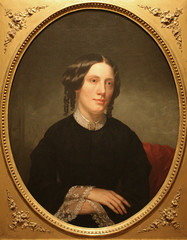In honor of black history month, I have been featuring African Americans, past and present, who have distinguished themselves in the field of literature. However, this week’s post is not about an African American, but a white woman who influenced the course of African slavery through her writing. Her name is Harriet Beecher Stowe, whose work sold in the millions, and who became an abolitionist and a defender of slaves.
Like Ann Petry who was featured last week, Harriet was born in Connecticut, one of three daughters to Lyman Beecher and Roxanna Foote. However, Harriet was born almost a century earlier on June 14, 1811. Her mother died when Harriet was only four years old and her older sister Catherine became her educator. Harriet enrolled in a seminary (girls’ school) run by Catherine, where she was educated in traditional “male” fashion in the classics, languages and mathematics.
In 1836 Harriet married Calvin Ellis Stowe, a seminary professor and staunch critic of slavery. He and Harriet supported the Underground Railroad, accommodating fugitive slaves in their home. In 1850 Congress passed the Fugitive Slave Law which prompted Harriet to pen her objections to slavery. Her first instalment of Uncle Tom’s Cabin, based on the life of Josiah Henson, a black slave, appeared in the antislavery journal National Era in 1851. It was intended to be a 40-week serial, but it became so popular that the publisher John Jewett asked Stowe if she would turn the series into a book. She initially doubted that anyone would want to read the story in book form, but eventually agreed.
The book caused such a sensation that President Abraham Lincoln was said to have exclaimed when he met Stowe, “So here is the little lady who made this big war.” The book was supposed to have been the catalyst that drove the abolitionist movement before the Civil War. In the United States it became the second best-selling book after the Bible, and in a few years over 1.5 million copies were in circulation in Great Britian, although some of them were said to be pirated copies. However, the book met with criticism from the Southern white populace who felt that the novel exaggerated the facts. In 1853 Harriet responded by writing A Key to Uncle Tom’s Cabin, a collection of slave interviews and newspaper clippings to verify the details. Some have also criticized the descriptions and behavior of the black characters, and in recent years the name Uncle Tom has become synonymous with African Americans who sell out to whites.
Harriet wrote Uncle Tom’s Cabin at the Harriet Beecher Stowe House in Brunswick, Maine and spent the last 23 years of her life at the Harriet Beecher Stowe House in artford, Connecticut, next door to Mark Twain’s house and died at the age of eighty-five. She is the author of over 20 books, including novels, travel memoirs and articles.
Related articles
- What Is an Uncle Tom? (brainz.org)
- Theater Review | ‘Uncle Tom’s Cabin’: Familiar Americana, but Still Full of Life (theater.nytimes.com)







